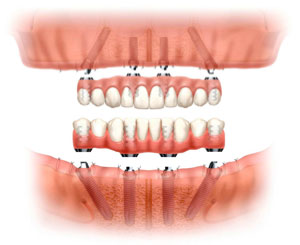 |
||
 |
Dental Implants
What is a Dental Implant? A dental implant is often the best replacement option for missing teeth. The implant is an artificial tooth root that replaces the root or roots of a missing natural tooth. Once the implant is secured in the jaw bone, it is not visible and can be used to support a crown, a bridge, or a denture. Dental implants are an option for people who have lost a tooth or teeth due to decay, periodontal disease, or trauma. Implants can also be used for orthodontic tooth movement.
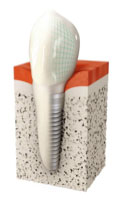 What are Dental Implants made of? Dental implants are made of titanium, a metal, which is strong, lightweight, and biocompatible. Therefore, the implant will not be rejected by the body. In fact, the implant actually fuses to the surrounding bone through a process called "osseointegration". When osseointegration occurs, the implant will not move or slip and the implant becomes a very strong foundation on which to place a crown, bridge, or removable prosthesis. Titanium is also used in artificial hips and knees. It has been reported that the success rate of dental implants is among the highest of any implanted surgical device. What Types of Tooth Replacement Options Are There? 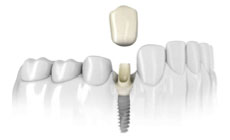
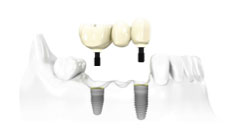
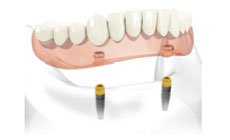
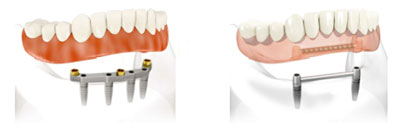
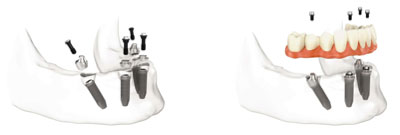
Are there any Disadvantages to having Dental Implants placed? The disadvantages to implant placement are few. They include:
Are You a Candidate for Dental Implants? A proper diagnosis must be made before an implant can be placed. The best candidate for an implant is in good general and oral health. There must be healthy gums and an adequate amount of bone to support the implant. The patient must also be committed to good oral hygiene and regular dental visits. Implant placement in children is usually deferred until jaw growth is complete unless the implant is part of the orthodontic treatment plan. 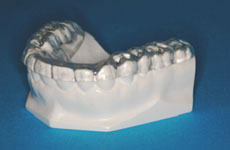 Are there any Contraindications to having a Dental Implant placed? Behaviors such as heavy drinking and smoking can affect the success of an implant. Bruxism (tooth grinding or clenching) may not only reduce the prognosis for successful implant treatment initially but for the life of the patient as well. A custom made bruxism appliance worn at bedtime can help minimize the forces of bruxism.
Are there any Contraindications to having a Dental Implant placed? Behaviors such as heavy drinking and smoking can affect the success of an implant. Bruxism (tooth grinding or clenching) may not only reduce the prognosis for successful implant treatment initially but for the life of the patient as well. A custom made bruxism appliance worn at bedtime can help minimize the forces of bruxism.
There are also certain diseases and conditions that can affect whether dental implants may be right for you. For example, uncontrolled diabetes, heart disease, cancer, or radiation therapy to the head or neck may affect the fusion of the implant to the bone. Patients with these conditions need to be evaluated on an individual basis. Implants are contraindicated in patients who take intravenous bisphosphonates for breast cancer. What is Involved in Getting a Dental Implant? A dental team plans the implant placement and restoration. This dental team consists of a surgeon who places the implants, a restorative dentist such as Dr. Mika who plans and places the restorations in the patient's mouth, and a dental laboratory technician who fabricates the restorations. All members of the team remain in close contact with each other during the case to assure optimum results. The first step in the process is the development of an individualized treatment plan that addresses your specific needs such as how many teeth you will need replaced. Prior to surgery, detailed radiographs will be taken. A CT scan may also be obtained to help plan the proper placement of the implants with a high degree of predictability. The dental team will determine what type of prosthesis will be fabricated followed by the number of implants, their length and diameter. A surgical stent with pre-drilled holes is sometimes fabricated to assist in implant placement. 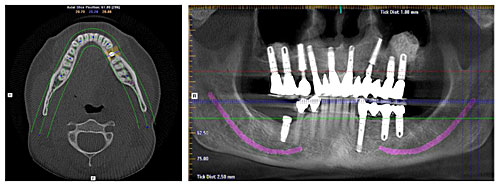 How are Dental Implants Placed? Precision channels are first prepared in the jawbone into which the implants will be placed. The implant remains in intimate contact with the bone during healing. As the bone heals, the implant and bone fuse in a process called osseointegration and the implant becomes securely anchored to the bone. How Successful is Dental Implant Surgery? Many studies have been conducted to determine the success rate for dental implants and most recent studies report success rates above 90%. Success is related to many factors including operator skill, the replacement tooth's purpose and position in the jaw, the quality and quantity of bone at the site, and the patient's general health, oral health, and oral hygiene. Are There Any Risks Involved with Implant Surgery? As is the case with any dental surgery, there are some risks involved which include: Infection, injury to surrounding teeth or blood vessels, nerve damage, and sinus problems. After surgery, bruising and minor bleeding may be experienced and you can expect some swelling and pain at the implant site. Your surgeon will prescribe the appropriate pain medications to keep you comfortable. When can Tooth Replacements be Placed on the Implants? After a hopeless natural tooth is removed, the jawbone is prepared for surgery which may involve bone grafting. Although some implants can be placed at the time of an extraction, three to four months of healing is usually required before an implant can be placed. After implant placement, it usually takes another three to six months for healing before a final tooth restoration can be placed. During these healing phases, a temporary denture can be made and placed for appearance. In certain cases, an implant and a restoration can be placed at the same time in a procedure called "Immediate Loading". In these cases, a temporary tooth is placed that cannot bite against an opposing tooth. This avoids forces on the implant while it osseointegrates with the bone. After osseointegration, a permanent tooth replacement is then placed that is capable of chewing. When is Bone Grafting Necessary? For a successful implant procedure, there needs to be bone in the jaw that is both thick enough and strong enough to support an implant against the powerful forces of chewing as well as the forces of parafunction (grinding and clenching habits). Placing bone grafts at the time of tooth extraction can help maintain the bone volume necessary for implants. Deformities in the upper and lower jaw can leave you with an inadequate amount of bone in which to place dental implants. These defects can be filled with bone graft material to build up the jawbone or ridge. Ridge modification can not only improve appearance but also improve the chances for successful implants. The upper posterior jaw is one of the most difficult areas to place implants due to insufficient quantity and quality of bone and because of the proximity of the maxillary sinus. A sinus augmentation procedure can raise the sinus floor and develop more bone for the placement of implants. Without an adequate amount of bone volume or density, an implant procedure would surely fail due to loss of supporting bone (resorption). What can cause a Dental Implant to Fail? The failure of an implant usually occurs when the implant does not fuse, or osseointegrate with the bone. If the implant does not fuse to the bone sufficiently, it is removed and the procedure can be done again at a later date. The risk of failure increases if the patient has any of the contraindications to implant placement discussed above. A condition called peri-implantitis may also develop. This is an inflammatory condition in the gums and bone around the implant which may result in bone loss and loss of the implant. Peri-implantitis is usually associated with a chronic infection and is seen most frequently in heavy smokers, diabetics, and in patients with poor oral hygiene. How are Implants Maintained? Poor oral hygiene is one of the main reasons why some implants fail. Because implants are metal, they cannot decay. However, they are susceptible to peri-implantitis which is an inflammatory response to the buildup of bacterial biofilm that can result in the loss of the implant. Dental Implants do require maintenance and must be cared for just like natural teeth. Excellent oral hygiene including brushing and flossing is a necessity as are regular dental check-ups. At your check-up appointment, your hygienist will clean your tooth replacements as well as the implant parts. Dr. Mika will make sure your implants are stable and your tooth replacements are functioning properly. Does Insurance Cover the Cost of Dental Implants? More and more insurance companies are helping to cover the cost of implants. Coverage varies from company to company and even between different plans within the same company. Dr. Mika's staff will help you to determine your level of coverage. |
| Joseph A. Mika, DDS, FAGD • (330) 702-6000
3700 Stutz Dr, Ste 3 • Canfield, OH 44406
1076665
|





